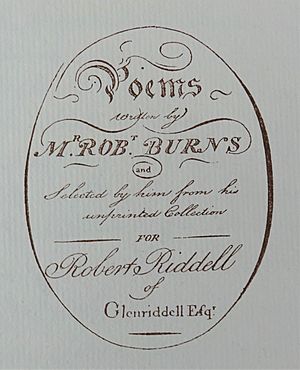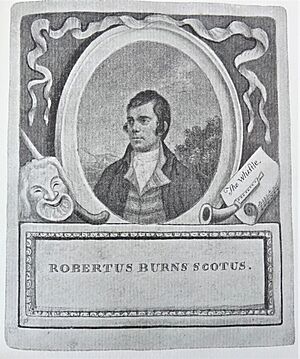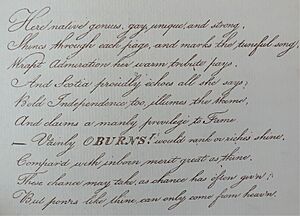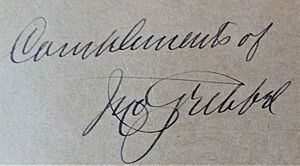Glenriddell Manuscripts facts for kids

Title page of the Glenriddell Manuscript. Volume 1
|
|
| Author | Robert Burns |
|---|---|
| Country | Great Britain |
| Language | Scots & English |
| Genre | Poetry, Letters and Lyrics |
The Glenriddell Manuscripts are a large collection of writings by the famous Scottish poet Robert Burns. These two special books contain his letters, poems, and some songs. They were made for his friend, Captain Robert Riddell, who lived at Friars Carse in Scotland.
The books were beautifully bound in leather. The first book, filled with poems and songs, was finished by April 1791. Burns gave it to Robert Riddell. Sadly, their friendship ended because of a misunderstanding. Robert Riddell died soon after, before they could make up.
The first book was written partly by Burns himself. A helper, called an amanuensis, wrote most of it in a very neat handwriting. The second book was written completely by Burns.
Contents
The Story of the Manuscripts

Robert Riddell gave Burns two nice leather-bound books. They had his family crest on them. Burns began writing poems and songs in them in May 1789. Burns's own family symbol was on the first page of the second book.
After Robert Riddell died in 1794, Burns worked hard to get the first book back. He added more writings to it once he had it. The second book was not ready in time to be given to Riddell.
In 1794, Burns wrote to Robert Riddell's sister, Eleanor. He asked her and her married sister to return or destroy the manuscripts. He said his writings were "unfit for the public eye" and that he had "some little fame at stake."
Where the Books Went Next
After Burns died, the manuscripts went to his biographer, James Currie. A biographer is someone who writes about another person's life. The books were not returned to Burns's family. After Currie died, his son, William Wallace Currie, got them.
In 1853, William's widow gave the books to a club called the Liverpool Athenaeum. They were forgotten in a box for about 20 years. In 1873, a man named Henry A. Bright found them. The club later decided to sell the manuscripts. Many people, especially in Scotland, were very upset about this.
A group called the 'Scots Committee' tried to stop the sale. They wanted the books to go back to Burns's family or to Scotland. The club said they would use the money from the sale to start a fund for James Currie.
Efforts to Return the Manuscripts
Sarah, Robert Burns's granddaughter, wrote a letter in 1893. She said it was wrong that the books were not returned to the family. She felt that the copyright for Currie's book about Burns should have gone to Burns's widow.
In 1913, a company called Sotheby's bought the manuscripts for £5000. Miss Annie Burns Burns, the poet's only living grandchild, tried to get the books back. The Liverpool Athenaeum still refused.
A book dealer named Joseph W. Hornstein bought the manuscripts from Sotheby's. He then sold them to an American client. There was a lot of confusion and secrecy around these sales. Many people in Scotland were very angry that these important Scottish treasures were being sold.
A Gift to Scotland
In late 1913, a kind businessman named John Gribbel was asked if he wanted to buy the manuscripts. On November 21, 1913, John Gribbel bought the Glenriddell Manuscripts. On the same day, he announced that he would give them as a gift to the Scottish people forever!
These manuscripts were one of the first big gifts to the new National Library of Scotland in 1926. Today, the two volumes are kept safely at the National Library of Scotland.
John Gribbel's Generosity
John Gribbel (1858–1936) was an American businessman and collector. His gift of the Glenriddell Manuscripts to Scotland is his most famous act of kindness.
John Gribbel also owned other important books by Robert Burns. These included four volumes of "The Scots Musical Museum." These books had about 140 pages of Burns's own notes about the songs he wrote. These special books had been owned by the Riddell family for a long time.
Copies of the Manuscripts
In 1914, John Gribbel had 150 copies of the manuscripts made. These were exact copies, called facsimiles. He did not sell them; he gave them away as gifts. The printing plates were destroyed so no more copies could be made.
In 1973, a new edition of "The Glenriddell Manuscripts of Robert Burns" was published. This allowed more people to see copies of the important writings.
After the Gift
After World War I, John Gribbel and his family visited Scotland in 1920. They were honored guests at many events. They also toured places in Scotland connected to Robert Burns.
John Gribbel visited Duncan McNaught, a teacher who was an expert on Robert Burns. Duncan McNaught had a huge collection of Burns's items. John Gribbel bought this collection, making sure it would be kept together as The McNaught Collection.
When John Gribbel died in 1936, his collection was sold. Parts of The McNaught Collection are now in universities in the United States.
What's Inside the Manuscripts
The first book of the Glenriddell Manuscripts contained 53 poems that had not been published before. The second book had 22 letters. Burns also added notes throughout the books. For example, he pointed out spelling errors made by his helper.
Burns wrote in the manuscript that if his poems were as good as his respect for Robert Riddell, they would be the best poems in any language.
The first book included important works like "Lament for James, Earl of Glencairn" and "Tam o'Shanter."
The pages in the books are numbered. In the helper's writing, the numbers are in the middle of the page. In Burns's writing, they are on the side. The books also have library stamps from the Liverpool Athenaeum.
Burns's Early Writings
Burns included a shorter version of his first "Commonplace Book" in the second volume. A commonplace book is like a personal notebook where someone writes down thoughts and ideas. He was still working on this part in late 1793.
Burns wrote that he found an old notebook from his younger years. He hoped that someday, even after he was gone, his thoughts would be found by someone who could understand their value.
Burns's Portrait
A portrait of Burns by John Beugo is included in both books. Alexander Nasmyth painted Burns, but John Beugo made the engraving for printing. Many people thought Beugo's picture looked more like Burns.
Poems and Songs in Volume One
Here are some of the poems and songs found in the first volume:
- Bonnie Dundee.
- Epistle to John Goldie, in Kilmarnock.
- Written in Friars Carse Hermitage.
- Holy Willie's Prayer.
- Tam O'Shanter - A Tale.
- On the death of Sir James Hunter Blair.
- The Humble Petition of Bruar Water to the Noble Duke of Athole.
- Lament of Mary Queen of Scots.
- The Whistle - A Ballad.
- Lament for James Earl of Glencairn.
Letters by Mr. Burns in Volume Two
Here are some of the letters found in the second volume:
- To William Nicol (Carlisle, June 1, 1787).
- To John Arnot of Dalquhatswood (April, 1786).
- To Alexander Cunningham (24th January, 1789).
- To Mrs. Stewart of Stair (September, 1786).
- To John M'Murdo (July, 1793).
- First Common-place Book (Abridged).
- To the Earl of Glencairn (February, 1787).
- To Miss Helena Craik (August, 1790).
- To Alexander Cunningham (11th June, 1791).
- To William Smellie (22d January, 1792).
See also
- Robert Burns's Commonplace Book 1783–1785
- Robert Burns World Federation
- Burns Clubs
- Irvine Burns Club
- The Geddes Burns




